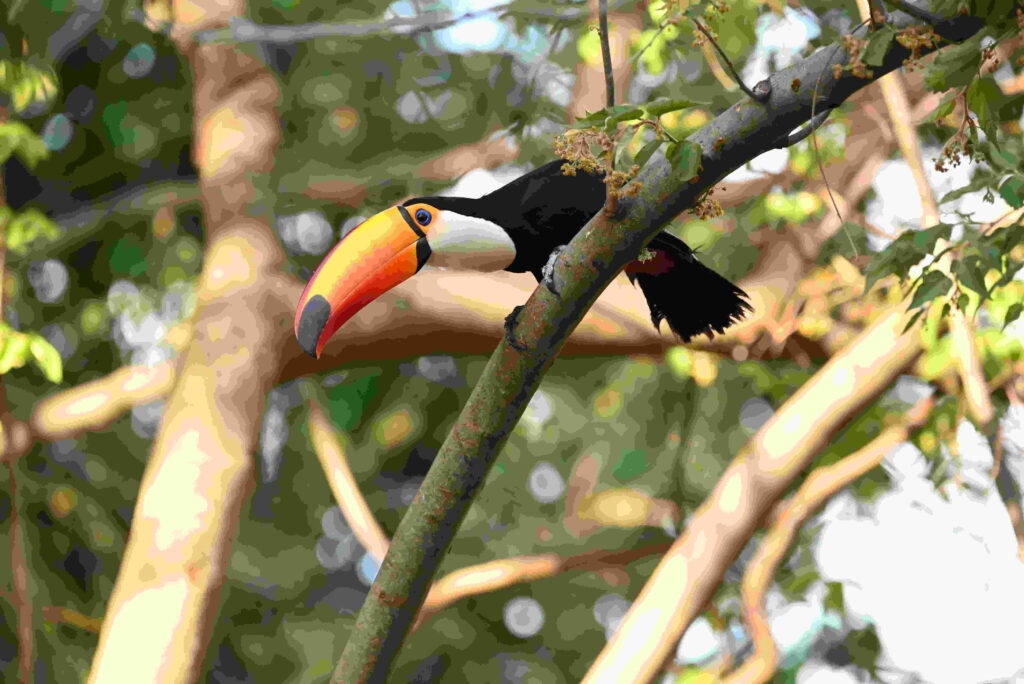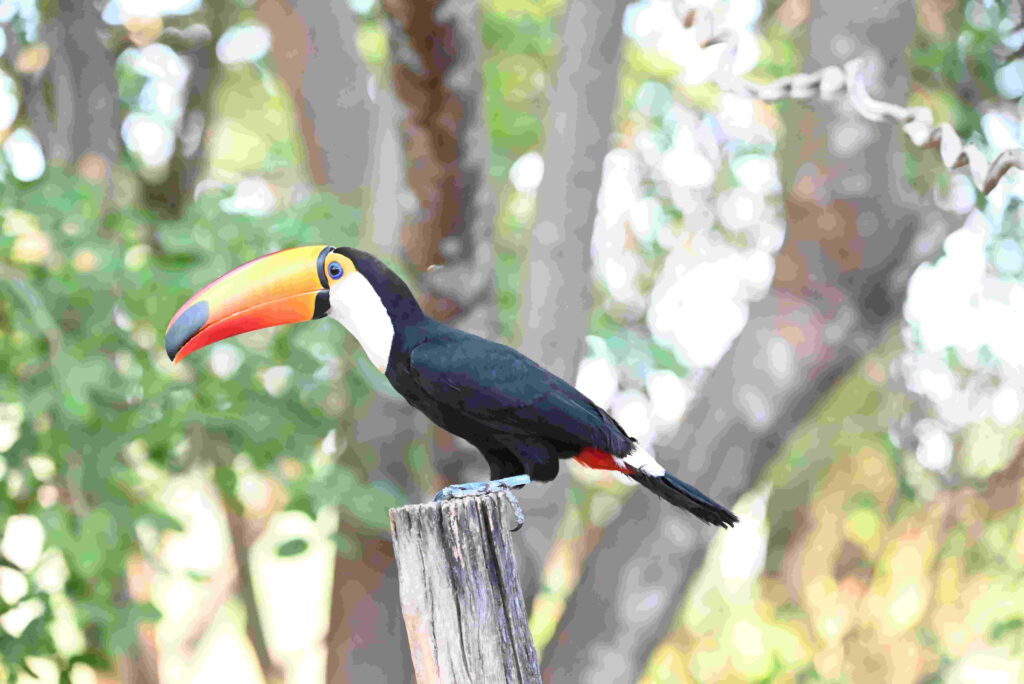

The Toco Toucan is an amazing bird, native to South America. It is famous for its beautiful appearance with a large, colorful bill that can reach lengths of up to 8 inches. This vibrant beak is not only visually captivating but also serves various purposes. Including regulating the bird’s body temperature and reaching fruits on distant branches. With a black body, white throat, and bright orange eye-ring. Furthermore, the Toco Toucan exhibits a contrast in colors. Basically, these social birds live in small flocks. In truth, they are skilled fliers, using their strong wings to navigate the lush rainforests they call home. While primarily fruit-eaters, they may also consume insects and small vertebrates. The Toco Toucan’s unique features and lively presence make it a fascinating species in the rich tropical biodiversity.
Symbol of South America.
The Toco Toucan, Ramphastos toco, stands out as one of the most iconic and visually wonderful bird species in South America. All in all, this captivating bird is native to various regions. Including the Amazon rainforest, the Pantanal, and parts of eastern Brazil.
Undoubtedly, the Toco´s oversized bill, can grow up to 8 inches in length. Moreover, this remarkable beak is a vibrant palette of colors. Featuring hues of orange, yellow, green, and black. Contrary to its substantial appearance. In truth, the bill is surprisingly lightweight due to its hollow structure. This impressive beak serves several functions. Basically, from regulating the bird’s body temperature by dissipating heat to helping in plucking fruits from tree branches. Interestingly, the bill’s closed edges assist in grasping and manipulating food items.
Basically, measuring around 25 inches in length, the Toco Toucan has predominantly black plumage. With a white throat patch. The vivid contrast between the black body and the orange eye-ring. Their eyes, surrounded by bare, blue skin, add a wonderful touch of uniqueness to their appearance.
Toco Toucan behavior.
These social birds are often found in small flocks, engaging in commun activities such as foraging for food or engaging in playful interactions. Toco Toucans are highly agile fliers, utilizing their powerful wings to navigate the dense vegetation of their habitat. Their flight is characterized by a distinctive undulating pattern, making them easily identifiable in their natural environment.
As frugivores, Toco Toucans primarily feed on a variety of fruits, including figs, berries, and small tropical fruits. However, their diet is not limited to fruits alone; they may also consume insects, small reptiles, and even the eggs, small mammals and lizards. Their eclectic diet contributes to their adaptability in diverse ecosystems.
Breeding pairs of Toco Toucans are known to form strong bonds, and they engage in cooperative activities such as nest-building and raising their offspring. The female typically lays two to four eggs in a tree cavity or an abandoned nests, like holes on trees, and both parents take turns incubating the eggs and caring for the chicks.
Toco Toucan in the Pantanal.
In the heart of the expansive Pantanal, a Toco Toucan finds its vibrant existence woven into the tapestry of this unique wetland ecosystem. Roaming through the mosaic of waterways, floodplains, and dense vegetation, this charismatic bird brings a burst of color to the subtropical landscape and it´s one of the favorite bird of visitors on a Pantanal safari.
Against the backdrop of lush greenery and meandering rivers, the Toco Toucan’s striking black plumage contrasts vividly with its oversized bill, painted in hues of orange, yellow, and green. This conspicuous beak, a masterpiece of nature’s design, serves not only as a tool for foraging but also as a beacon of the Pantanal’s biodiversity.
Pantanal´s rain and drain.
Regarding to the rainy and dry season of the Pantanal. Basically, the Toco Toucan engages in the dynamic rhythm of life. Moreover, during the wet season, when water levels rise. The bird flies through flooded forests. Its powerful wings allows it to move from tree to tree in search of fruits. All in all, as the dry season descends, the Toco Toucan adapts its strategies. Exploring the diverse of fruits and insects that live in the landscape. Moreover, the Toco Toucan shares its habitat with other species. Like reptiles, and mammals. Within this web of life, the toucan’s call sounds through the wetlands a distinctive blend of croaks and rattles. Adds to the symphony of Pantanal sounds.
Toco Toucan reproduction.
Nesting high in the branches of trees, the Toco Toucan establishes its breeding grounds. Here, the pair collaborates in the careful construction of a nest within a suitable tree cavity. In truth, the female lays a clutch of eggs, and the parents take turns incubating them. Basically, Their partnership shows harmony in the Pantanal’s diverse ecosystem.
Furthermore, as the Toco Toucan gracefully glides through the Pantanal’s waterways and trees. It not only symbolizes the resilience of life in this unique wetland but also stands as a testament to the species.
The Toco Toucan, living in the diverse ecosystems of South America, has adapted its diet and behavior to ensure survival in its challenging habitat. A primary aspect of its lifestyle revolves around its diet, mainly consisting of fruits.
Beyond fruits, the Toco Toucan displays opportunistic feeding behaviors. It supplements its diet with insects, small reptiles, and, on occasion, the eggs of other birds. This adaptability in dietary choices enhances its chances of finding sustenance in the ever-changing South American landscape.
Toco Toucan capabilities.
Flight is a crucial aspect of the Toco Toucan’s survival strategy. With its powerful wings, it gracefully navigates the dense rainforests and varied landscapes of South America. The undulating pattern of its flight allows it to cover significant distances, reaching isolated fruiting trees and responding to the dynamic nature of its environment.
Breeding habits also contribute to the species’ persistence. Toco Toucans form strong, monogamous bonds during the breeding season. They collaborate in nest-building, selecting secure tree cavities for protection. This cooperative approach extends to incubating eggs and caring for the fledglings, ensuring the next generation’s successful integration into the intricate web of life in South America.
In essence, the Toco Toucan’s survival in South America is a testament to its adaptability, social dynamics, and the specialized tools nature has provided, such as its remarkable bill. This bird, with its vibrant presence and resourceful behaviors, continues to thrive amidst the rich and ever-changing ecosystems of the continent.
How deforestation impact other wildlife?
The Toco Toucan, native to South America, faces significant challenges in deforested areas. As these vibrant birds primarily rely on large expanses of tropical forests for both habitat and food sources, deforestation disrupts their natural environment. The loss of trees diminishes the availability of fruits and insects, impacting the toucan’s diet and overall well-being. Additionally, the fragmentation of once-connected habitats further isolates populations, making it difficult for these iconic birds to thrive. Conservation efforts are crucial to mitigate the impact of deforestation on Toco Toucans and preserve their unique place in the ecosystem. Meanwhile, Toco Toucans can adapt plantations, the species grows more than others. It causes a disbalance in nature, as it predates other birds.



